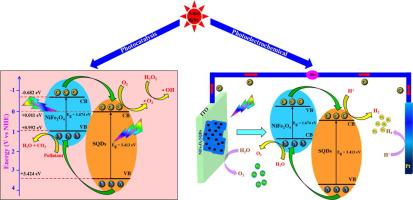Journal of Electroanalytical Chemistry ( IF 4.1 ) Pub Date : 2021-09-15 , DOI: 10.1016/j.jelechem.2021.115699 Bathula Babu 1 , Ravindranadh Koutavarapu 2 , Jaesool Shim 1 , Jonghoon Kim 3 , Kisoo Yoo 1

|
In this study, nickel ferrite (NiFe2O4) was prepared by a simple wet chemical procedure followed by calcination, and tin oxide (SnO2) quantum dots (SQDs) were prepared by a chemical reduction approach. Additionally, a NiFe2O4–SQD (NF–SQDs) nanocomposite was prepared by a hydrothermal approach. The NF–SQDs nanocomposite was analyzed using several techniques, such as X-ray diffraction (XRD), scanning electron microscopy (SEM), transmission electron microscopy (TEM), diffuse reflectance spectroscopy (DRS), and electrochemical investigations. The NF–SQDs nanocomposite showed promising properties for use as a novel nanomaterial in the degradation of the water pollutant, tetracycline (TC), and was used for photoelectrochemical (PEC) water oxidation. The successful preparation of the NF–SQDs nanocomposite was confirmed by XRD, SEM, TEM, and DRS. Morphology analysis confirmed the successful decoration of SQDs on the NiFe2O4 nanoplates. The bandgap of the NF–SQDs nanocomposite was modified because of the formation of a heterojunction. The NF–SQDs nanocomposite degraded TC within 70 min under simulated sunlight irradiation and effectively separated the photogenerated charge carriers to improve the degradation efficiency. Detailed PEC investigations revealed a low charge-transfer resistance, excellent photocurrent response, and high stability of the NF–SQDs nanocomposite. The detailed potential mechanisms for the photocatalytic degradation of TC and PEC water oxidation are discussed herein with schematics.
中文翻译:

锚定在镍铁氧体纳米板上的氧化锡量子点改进了太阳光驱动的四环素光催化减排和光电催化水氧化
在这项研究中,镍铁氧体 (NiFe 2 O 4 ) 通过简单的湿化学程序制备,然后煅烧,氧化锡 (SnO 2 ) 量子点 (SQD) 通过化学还原方法制备。此外,NiFe 2 O 4-SQD(NF-SQDs)纳米复合材料是通过水热法制备的。使用多种技术分析了 NF-SQDs 纳米复合材料,例如 X 射线衍射 (XRD)、扫描电子显微镜 (SEM)、透射电子显微镜 (TEM)、漫反射光谱 (DRS) 和电化学研究。NF-SQDs 纳米复合材料作为一种新型纳米材料在水污染物四环素 (TC) 的降解中表现出良好的性能,并用于光电化学 (PEC) 水氧化。通过 XRD、SEM、TEM 和 DRS 证实了 NF-SQDs 纳米复合材料的成功制备。形态分析证实了 SQDs 在 NiFe 2 O 4上的成功装饰纳米片。由于异质结的形成,NF-SQDs 纳米复合材料的带隙被修改。NF-SQDs 纳米复合材料在模拟阳光照射下 70 分钟内降解 TC,并有效分离光生载流子以提高降解效率。详细的 PEC 研究表明,NF-SQDs 纳米复合材料具有低电荷转移电阻、优异的光电流响应和高稳定性。本文通过示意图讨论了光催化降解 TC 和 PEC 水氧化的详细潜在机制。











































 京公网安备 11010802027423号
京公网安备 11010802027423号